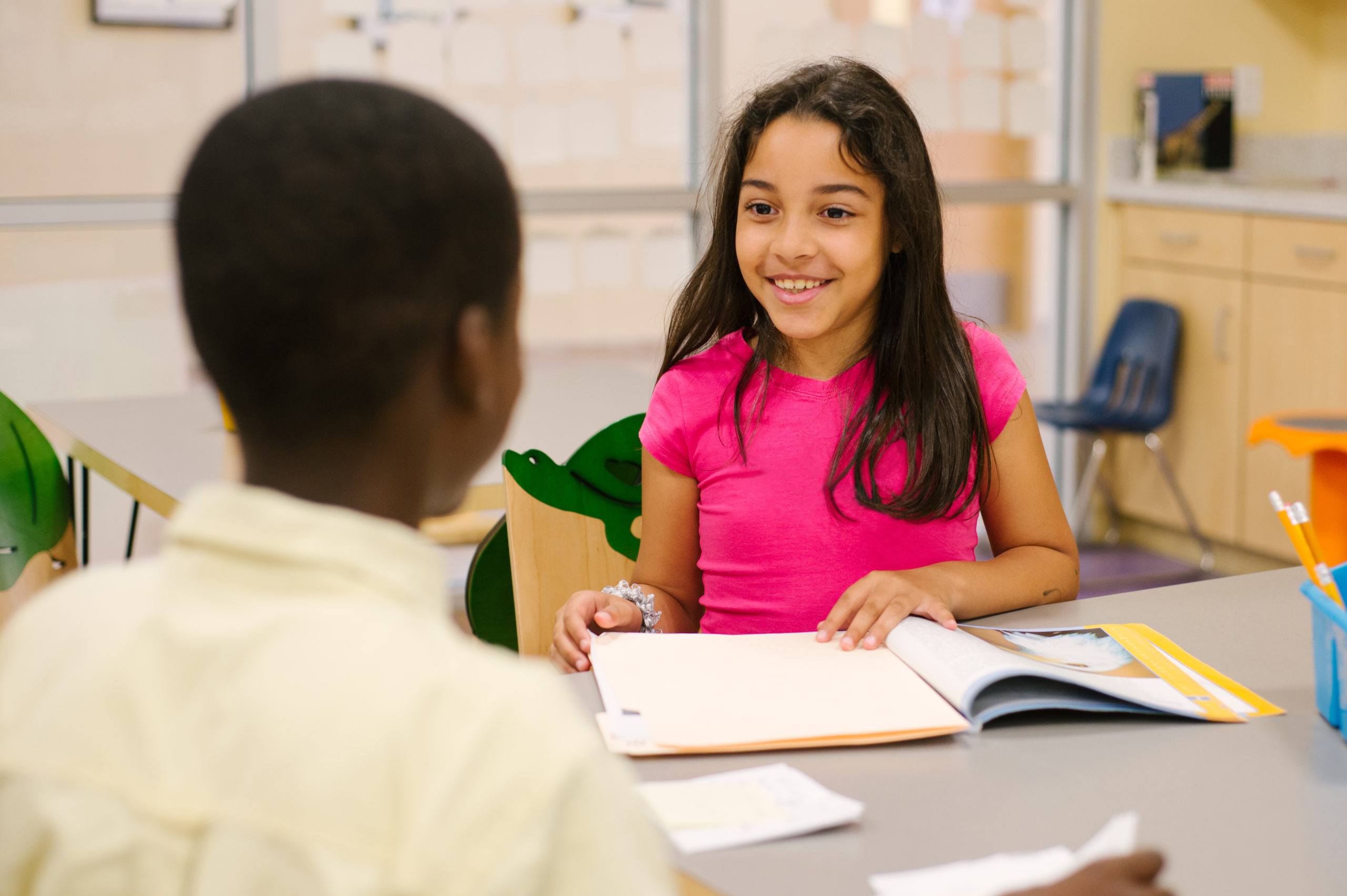Here at Collaborative Classroom, we are committed to helping students develop a lifelong passion for reading. We believe this passion is nurtured when students have opportunities to engage in authentic reading experiences within a safe and collaborative learning community.
Authentic reading takes many shapes and forms. Readers benefit by gathering as a whole class to read and discuss a text together. Readers need lots of time to independently read books they choose. Small, flexible groups also play a pivotal role in supporting students’ growth towards independence in the upper elementary grades.
But what does powerful small-group learning look like? What does it feel like?

To help us explore these questions, Collaborative Classroom is honored to partner with Julie Wright, author of the book What Are You Grouping For?, Grades 3–8: How to Guide Small Groups Based on Readers—Not the Book (Corwin, 2019). In this two-part series, we share some of our collective thinking for launching and sustaining small groups in grades 3–6.
In today’s blog post, Julie shares insights about small groups; then we collaborate to provide some tips on how to manage your classroom and your instructional time during small-group learning. Happy Reading! —Katy Cortelyou, EdD, Collaborative Classroom
The Power of Small-Group Learning
As an educational consultant and instructional coach, the schools I support are often located in different places on the map and serve different populations and needs, but they all have something very basic, and important, in common. People who work in schools show up to “do good work.” That’s it, plain and simple. “Doing good work” can look and feel as different as the individuals involved, but the common thread is that school folks, day-in and day-out, invest time and effort to support the students in their learning communities.
A problem of practice that transcends these settings and zip codes is how to provide the right amount of support, at just the right time, to maximize student growth.
A problem of practice that transcends these settings and zip codes is how to provide the right amount of support, at just the right time, to maximize student growth. One solution to combat this challenge is using proximity—getting up close to students’ work, conversations, and interactions—through small-group learning experiences.
My stance is grounded in the following beliefs about small groups:
- When kids meet and talk a lot in small groups, they feel a sense of connection and belonging.
- This sense of connection and belonging provides safe spaces for kids to take risks as they read, write, think, and talk freely and develop intrinsic motivation.
- Increased motivation and freedom bolster reading volume, access, and choice, which, in turn, grows reading muscles and enhances students’ literacy journeys.
Whether I’m providing support face-to-face or through remote/online platforms, these beliefs hold true. I believe it’s essential for students to meet in small groups so that they can connect with others, take risks, and take advantage of learning opportunities that will positively benefit their literacy growth.
Planning Our Small Groups
For years, small-group learning resembled students sitting around a horseshoe shaped table, with students paying close attention to the teacher who sat at the center. Often, the work included an extra dose of skills that were recently taught during a direct instruction lesson or focused on a teacher-selected, leveled book. These experiences were teacher-guided in nature, with a frequency, intensity, and duration equally divided among groups or adjusted based on students’ needs and/or time available.
Now, if you are thinking, wait … I’ve taught that way and it worked for lots of students, you’re probably right. I’m not suggesting that your small-group learning efforts weren’t fruitful. In fact, I’m sure there were many benefits.
However, as students progress through the upper elementary grades, I’m suggesting we make an extra effort to take their curiosity, passions, and interests into account as we plan. I find that this data is a great driver for grouping decisions.
When we take what we know about students into account and design learning opportunities around that information, motivation and engagement naturally increase.
That’s because when we take what we know about students into account and design learning opportunities around that information, motivation and engagement naturally increase. In other words, harnessing what gets kids jazzed up gives us a leg up when teaching into students’ academic, social-emotional, and physical needs.
Launching and Sustaining Small Groups
I’d be remiss if I didn’t mention some challenges in launching and sustaining small-group learning. For example:
| CLASSROOM MANAGEMENT | TIME |
| What will the other students do while the teacher is with the small group? | How will we ever fit in all of the content we need to teach? |
These are real concerns from educators and should not be addressed lightly. Rather, they can be solved in creative and responsive ways!
Read on to learn some tips from me and from Collaborative Classroom for overcoming these hurdles, while also utilizing students’ interests and passions, making small-group learning experiences a go-to solution for meeting students’ wants and needs.
Tip #1: Harness Student-Led Small Groups to Foster Student Independence
Teachers take student learning time seriously—thank goodness! It’s no surprise that when I suggest increasing small-group interactions, many express concerns about classroom management while meeting with a small group. That’s because learning time is precious, and educators want students to be on-task and engaged in meaningful work.
One solution is to have multiple student-led small groups meeting at the same time, which will help foster student independence and ensure that all students have meaningful work to do across the learning time.
Try This!
Meet with the whole class and explain that small groups will be meeting at the same time, and you’ll be moving around the classroom to join each group. To make this experience successful, create some shared agreements with the students by explaining:
- Students will not wait for you to begin their small-group meeting. One student will need to be the facilitator. This person will keep the group on track and focused on the task. The facilitator will also make sure everyone in the group has time to talk and share.
- When students meet, they will read the text that has been provided (together or independently depending on what the small group decides) and then talk about the gist of what the author was trying to say or teach the reader.
- The students will remember to use active listening skills (eye contact, positive non-verbal communication, and body language).
- When students are finished meeting as a small group, they will move quietly into independent reading of books of their choice, without disturbing others.
After each group concludes, meet again as a whole group to talk about what went well and what needs improvement. Celebrate and make adjustments as needed.
Tip #2: Providing Support and Setting Goals for More Robust Discussions

A strong foundation is critical for harnessing the power of student-led small groups. This means doing the work in Julie’s Tip #1 to help students generate shared agreements for how small-group learning will proceed and learn to manage time before, during, and after each session. In addition, we often notice that students need intentional support to elevate the quality of their small group discussions. Supporting group members in setting their own goals for improving discussions goes a long way towards independence!
Try This!
- Gather with the small group members and share the importance of reflection and goal setting to improve the quality of the student-led discussions.
- Ask students to discuss: “What is your group doing well in your discussions?”
- Ask students to share their thinking, capture their ideas on a chart, “What We Are Doing Well.”
- Then ask students to consider, “What is something your group could do to improve discussions?” Encourage students to share with a group member next to them.
- Bring the whole class back together, inviting students to share. Capture students’ ideas on a chart, “Ways We Can Improve.”
- After generating this shared list of ideas for elevating conversations, encourage the group to focus on one idea from the list they can agree to work on during that day’s student-led small group time.
- Students then engage in the discussion for the day and end the time together by reflecting on the goal they set for themselves.
This tip is inspired by our “Setting the Foundations” lessons from the Collaborative Classroom Book Clubs curriculum for grades 3–6, in which we embrace the power of student-led small-group learning as a means for fostering students’ independence as readers, writers, and collaborators.
Tip #3: Create Integrated Mini-Units to Connect Content and Maximize Time
Small-group learning takes a lot of time. The school day and year aren’t getting any longer and curriculum demands aren’t decreasing, so where do we get the time needed for small-group learning?
One practical solution is to create integrated mini-units and use small-group learning experiences as the vehicle for learning about and sharing new ideas. This helps students deepen their knowledge by making connections across content areas, ultimately maximizing learning time.
Try This!
- Select some content from either science or social studies. During the time when students might typically be reading independently, give students a short text such as an infographic or a primary document excerpt that they can read together in a small group.
- In order to create quick pop-up groups for this learning experience, ask students to name their favorite season and group students based on their selection. Break larger groups into two smaller groups, where applicable, so that each group has three to four members.
- Students can meet once to read and discuss the text or they can meet several times, re-reading the same text or reading new ones.
Launching these small-group learning efforts will get students excited about learning new, connected content and serve as a big time saver.
***
We at Collaborative Classroom appreciate the core beliefs that underpin Julie’s vision for small-group learning. We, too, believe that connection and collaboration are at the heart of student learning and engagement.
Of course, our work with students is never done. We are always asking ourselves, “How might we support students’ continued growth and development as independent readers?” In the second part of this blog series, we will share additional tips for sustaining successful small-group learning.
Until then, we leave you with a question to reflect upon: how are you using flexible small groups to foster students’ passions, interests, and curiosities?
